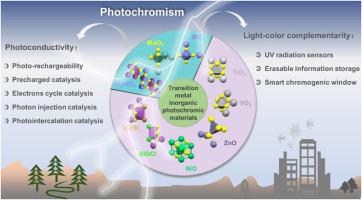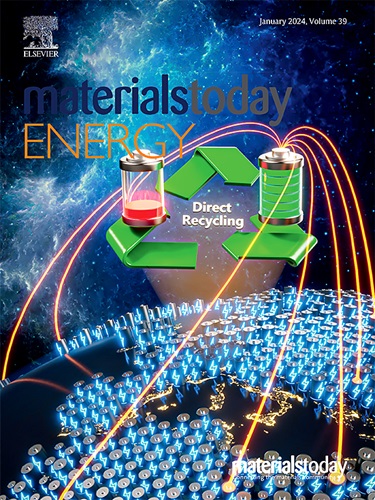Light-to-color conversion on MoO3, WO3, and Bi2WO6: from mechanism to materials and applications
IF 8.6
2区 材料科学
Q1 CHEMISTRY, PHYSICAL
引用次数: 0
Abstract
Because of their good chemical stability and excellent optical properties, MoO, WO, and BiWO are important in photochromism. Their light-to-color conversion is highly dependent on the electronic band structure and charge transfer, and they obey the mechanism of electron accumulation in semiconductors when excited within the bandgap. Pure semiconductors face limitations in practical applications due to insufficient light absorption, charge carrier recombination, and low charge capacity. Diverse forms of photochromic hybrids (nanopowders, films, hydrogels, and multilayer structures) with rapid change, repeatability, and reversibility are possible via nanocustomization, surface/interface engineering, heterojunction fabrication, and complexing organic ligands. Manipulating the function of photochromic systems through light stimulation is becoming an attractive paradigm, divided into two branches: light-color complementarity and photoconductivity. This review examines the widely accepted photoresponsive principles and the still controversial energy transfer models. We emphasize the correlation between material properties and performance enhancement to inspire the rational structure design. The bottlenecks in current development are identified by analyzing application-specific innovation concepts, fabrication processes, and performance metrics. In addition, we present several perspectives to encourage meaningful multidisciplinary collaboration.

MoO3、WO3 和 Bi2WO6 上的光色转换:从机理到材料和应用
MoO、WO 和 BiWO 具有良好的化学稳定性和优异的光学特性,因此在光致变色方面具有重要作用。它们的光色转换高度依赖于电子带结构和电荷转移,在带隙内激发时遵循半导体中的电子积聚机制。由于光吸收不足、电荷载流子重组和电荷容量低等原因,纯半导体在实际应用中受到限制。通过纳米定制、表面/界面工程、异质结制造和复合有机配体,可以实现具有快速变化、可重复性和可逆性的各种形式的光致变色混合体(纳米粉体、薄膜、水凝胶和多层结构)。通过光刺激来操纵光致变色系统的功能正成为一种极具吸引力的范例,它分为两个分支:光色互补性和光导性。本综述探讨了广为接受的光致变色原理和仍有争议的能量传递模型。我们强调材料特性与性能提升之间的相关性,以启发合理的结构设计。通过分析特定应用的创新理念、制造工艺和性能指标,我们发现了当前发展的瓶颈。此外,我们还提出了鼓励有意义的多学科合作的若干观点。
本文章由计算机程序翻译,如有差异,请以英文原文为准。
求助全文
约1分钟内获得全文
求助全文
来源期刊

Materials Today Energy
Materials Science-Materials Science (miscellaneous)
CiteScore
15.10
自引率
7.50%
发文量
291
审稿时长
15 days
期刊介绍:
Materials Today Energy is a multi-disciplinary, rapid-publication journal focused on all aspects of materials for energy.
Materials Today Energy provides a forum for the discussion of high quality research that is helping define the inclusive, growing field of energy materials.
Part of the Materials Today family, Materials Today Energy offers authors rigorous peer review, rapid decisions, and high visibility. The editors welcome comprehensive articles, short communications and reviews on both theoretical and experimental work in relation to energy harvesting, conversion, storage and distribution, on topics including but not limited to:
-Solar energy conversion
-Hydrogen generation
-Photocatalysis
-Thermoelectric materials and devices
-Materials for nuclear energy applications
-Materials for Energy Storage
-Environment protection
-Sustainable and green materials
 求助内容:
求助内容: 应助结果提醒方式:
应助结果提醒方式:


